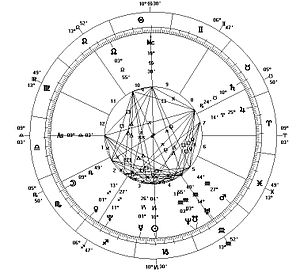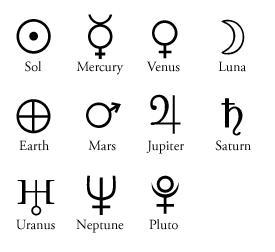Horoscope
In astrology, a horoscope is a chart or diagram representing the positions of the planets, other celestial bodies, and sensitive angles at the time of any event, such as a person's birth. The term horoscope is derived from Greek words meaning, "a look at the hours" [horoskopos, pl. horoskopoi,or "marker(s) of the hour."] Other commonly used names for the horoscope in English include natal chart, natus, birth chart, astrological chart, astro-chart, celestial map, sky-map, nativity, star-chart, cosmogram, Vitasphere, soulprint, radical chart, radix, or simply chart, among others.

Introduction
Using an ephemeris and a table of houses an astrologer calculates the geocentric positions of the Sun, Moon, and planets for a specific time and place in order to erect a formatted horoscope. This diagram, often called a chart, is a stylized map of the heavens. The sun or the earth is placed in the centre (depending on whether the ephemeris was heliocentric or geocentric) with the remaining elements around the outside: the planets, the lunar nodes, the ascendant, midheaven, and the houses. Then the angles between the planets, called aspects, are determined. Different systems of tri-secting arcs produce houses of different size.
In common usage, the word horoscope often refers to the astrologer's interpretation of the chart. In particular, many newspapers and magazines carry horoscope columns, describing planetary positions and influences for the placement of the Sun at the time of birth. However, most horoscopic astrologers regard these as worthless since a horoscope is actually highly personalized and its interpretation cannot be generalized to thousands of readers just through one planetary placement.
To manually create a horoscope an astrologer first has to ascertain the exact time (adjusting for any daylight savings time or war time in use) and place of the subject's birth or the initiation of an event. This is then translated into Greenwich Mean Time at that same instant, which in turn is translated into the sidereal time at Greenwich. The astrologer will then consult a set of tables called an ephemeris which lists for a particular year, date and sidereal GMT time, the location of all the planets, the Sun and Moon with respect to the northern hemisphere vernal equinox or the fixed stars (depending on which astrological system is being used). The astrologer then uses the time difference between GMT and local time at the place of birth to show where planets would be visible above the horizon at the time and place in question. Planets hidden from view beneath the earth are also shown in the horoscope. Finally a table of houses is used to divide the horoscope into 12 divisions around the circle of the ecliptic starting from the eastern horizon where objects are just rising into view. These are called the houses and numerous systems of calculating these divisions exist.
Construction of a horoscope
In order to understand and visualize the geometry of the construction of a horoscope, one must be familiar with a number of concepts.
Concepts
The techniques described here belong to Western astrology.
- The native refers to the time and place of the event being charted, and considered to be at the centre of the celestial sphere. This term is a general one that includes not only birth times, but any event for which a horoscope would be drawn.
- The celestial sphere is a sphere of arbitrary radius upon which the items appearing on the horoscope are projected without regard to their distance from the native.
- The plane of the equator is the plane of the earth's equator projected into space.
- The plane of the ecliptic is defined by the orbits of the earth and the sun. For practical purposes the plane of the equator and the plane of the ecliptic maintain a constant inclination to each other of approximately 23.5°.
- The plane of the horizon is centred on the native, and is tangential to the earth at that point. In a sphere whose radius is infinitely large this plane may be treated as nearly equivalent to the parallel plane with its centre at the earth's center. This greatly simplifies understanding the geometry of the horoscope. Some writers on astrology have considered the effects of parallax, but most would agree that (apart from that of the moon) they are relatively minor, and are beyond the scope of this article.
- The axis of the plane of the horizon has end points above, the zenith, and below, the nadir.
- The zodiac refers to the 18° wide band on the celestial sphere containing the signs. It is centered on the ecliptic, and its width is sufficient to allow for the fact that the orbits of the moon and all other planets are not parallel to the plane of the ecliptic.
- The medium coeli or midheaven is the point on the ecliptic that is furthest above the plane of the horizon; its opposite point is known as the imum coeli. For events occurring where the planes of the ecliptic and the horizon coincide the limiting position for these points is at 90° from the ascendant.
- The ascendant is the eastern point where the ecliptic and horizon intersect. Its opposite point in the west is the descendant. In creating a horoscope the ascendant is traditionally placed as the left-hand side point of the chart. During the course of a day, because of the earth's rotation, the entire circle of the ecliptic will pass through the ascendant and will be advanced by about 1°. This provides us with the term rising sign, which is the sign of the zodiac that was rising in the east at the time.

- The sun sign is the sign of the zodiac in which the sun is located for the native. This is the single astrological fact most familiar to people. If an event occurs at sunrise the ascendant and sun sign will be the same; other rising signs can then be estimated at approximately two hour intervals from there.
- The houses are a series of twelve divisions of the plane of the ecliptic. Astrologers have devised many systems of calculating these house divisions. In the case of the equal house system the ecliptic is divided into twelve equal houses of 30° each. The first house begins at the ascendant and the others are numbered counterclockwise from that point. The first six are therefore below the horizon, and the other six are above. The positions of these houses remains fixed relative to the native. The signs and planets all move through the twelve houses during the course of a day, and the planets move through the signs over the course of months or years.
- An aspect is the relative angle between two heavenly bodies. The more exact the aspect is, the more important it is said to be. The difference between the exact aspect and the actual aspect is called the orb.
- Most Western Astrologers use the tropical zodiac in which the astrological year begins with the vernal equinox, when the sun crosses the celestial equator and enters the zodiac sign of Aries. Astrologers in India and some Western astrologers use the more ancient sidereal zodiac. Many students confuse the difference between sidereal constellations and tropical zodiac signs. Because of a "wobble" in the earth's axis of rotation over a period of about 26,000 years the point at which the vernal equinox advances in the sky rate is 0 deg, 0 min, 50.23 secs a year. Precession of the equinox is roughly 5 minutes of a degree every 6 years. Sidereal astrologers use zodiac signs that roughly align with the constellations. Tropical astrologers use zodiac signs that align with the vernal equinox in the northern hemisphere and so the signs relate to the seasons and not the stars.
- A cusp is the boundary between two signs or houses. For some the cusp includes a small portion of the two signs or houses under consideration.
Construction
The chart thus begins with a framework of 12 houses. Upon this the signs of the zodiac are superimposed. In the equal house system the cusp between any two houses will fall at the same degree for each of the signs. Thus, for a native whose ascendant is at 12° of Leo, the second house will begin at 12° of Virgo, the third at 12° Libra, and so on. In house systems that take into consideration the effects of the angle of intersection between the planes of the horizon and the ecliptic, the calculations are more complicated. For these calculations it is essential to know the latitude of the event. Tables are available for these calculations, but they are now commonly calculated by computer. Most astrology computer programs allow the user to choose from a variety of house systems. The most commonly used is the Placidus house system, though most research astrologers find that the Koch domification system gets best results.
Ascendent
Longitude is necessary in order to determine the position of the ascendant because horoscopes use local time. Due to time zones, adjustments are made for the difference in one's actual longitude and the longitude of the nominal meridian associated with clock time.

Placements
Having established the relative positions of the signs in the houses, the astrologer positions the sun, moon, and planets at their rightful celestial longitudes. Some astrologers also take note of minor planetary bodies, fixed stars, asteroids (for example, Chiron) and other mathematically calculated points and angles such as the vertex, equatorial ascendant, etc. Many astrologers also use what are commonly referred to as Arabic parts (or Greek Lots), the most common of which is the Part of Fortune (Pars Fortuna).
Aspects
To complete the horoscope the astrologer will consider the aspects or relative angles between pairs of planets. Certain aspects are considered more important than others. Those generally recognized by the astrological community are Conjunction (0°), Opposition (180°), Square (90°), Trine (120°), Sextile (60°), Semi-Square (45°), Sesqisquare (135°), and Quincunx (150°). Understandably these aspects are more significant when they are exact, but they are considered to function within an orb of influence, the size of which varies according to the importance of each aspect. Thus conjunctions are believed to operate with a larger orb than sextiles. Most modern astrologers use an orb of 8° or less for aspects involving the Sun, Moon, and Jupiter and smaller orbs for the other points. Some astrologers, such as practitioners of Cosmobiology, and Uranian astrology, use minor aspects (15°, 22.5°, 67.5°, 72°, 75°, 105°, 112.5°, 157.5°, 165°) with much narrower orbs.
Reference: Dona Marie Lorenz, Tools of Astrology: houses, Topanga, Eomega Grove Press, 1973. Andrew Homer (StarHeart): See "The Only Way to Learn Astrology" series by Marion March & Joan McEvers.
External links
- AstroDienst - Free online horoscope calculation
- AstrologyWeekly - Articles and tools dealing with modern horoscopic astrology
- Hindu Astrology - Astrological prediction based on Hindu Horoscopes and Stars.
- Skyscript — Classical Astrology - A modern yet faithful look at classical astrology.
- Astrouniverse Celebrity horoscope directory.
- Futurescopes A horoscope directory.
- Horoscope (Birthchart) - Horoscope (Birthchart) in Indian Languages (Tamil, Telugu, Hindi & English)
